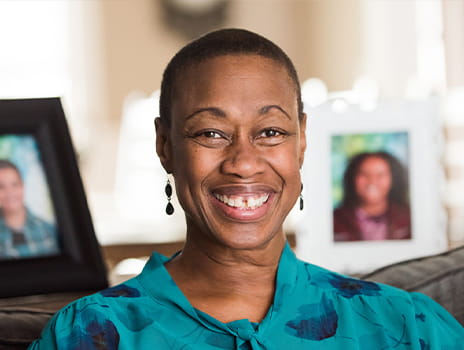Liver Transplant Brings a Second Chance at Life

In recognition of the upcoming Martin Luther King Jr. Day holiday, some of The University of Kansas Health System’s offices will have modified hours on Monday, January 19.
The University of Kansas Health System is experiencing a high volume of patients seeking care for influenza and other respiratory illnesses. Whether you plan to visit the health system or not, learn how to keep yourself healthy.

November 05, 2018
Brenda Adams and her husband, Darrell, appreciate the simple joys of life. Barbecues. Sports. Fishing. Time with family – and with 5 children and 17 grandchildren between them, there's a lot of family to fill their time.
"We are simple people who enjoy everyday things," says Brenda, who lives in Topeka, Kansas.
But even living simply became a significant challenge when Brenda faced liver failure.
Since the age of 15, Brenda experienced seizures, so she wasn't a stranger to health concerns. But in June 2010, she got very sick. She visited her primary care physician, who ordered a full blood workup. Tests revealed Brenda was diabetic. As she learned to control the diabetes, she received more difficult news. She also had hepatitis C. She had a liver biopsy and soon began vomiting blood the consistency of coffee grounds. Her local doctor referred her to The University of Kansas Health System and the care of hepatologist Ryan Taylor, MD.
"I wasn't afraid," she says. "I knew I was in good hands, and I didn't believe it was my time to go."
But additional complications were ahead. A full evaluation revealed jaundice and cirrhosis. Brenda worked with Dr. Taylor to manage her condition with medications for several years, but by February 2015, she had developed liver cancer. She received targeted chemotherapy and microwave ablation, but also was added to the waiting list for a liver transplant.
As Brenda awaited the organ, hematologist/oncologist Raed Al-Rajabi, MD, led her cancer care.
"Patients fighting cancer while awaiting transplant require significant collaboration among specialties," Dr. Al-Rajabi says. "We take a team approach to achieve the best patient outcome. When the tumor is large, we focus on shrinking it before transplant. When the cancer is small enough to meet transplant criteria, we focus on preventing it from spreading. We coordinate across disciplines to control the cancer as we see the patient through to transplant."
Microwave ablation entailed inserting a needle with a probe into the center of the tumor and heating it to a high temperature to kill cancer cells. Chemoembolization is a treatment in which chemotherapy-filled beads are delivered directly to the blood vessels feeding the tumor. Brenda's interventional radiologist used microcatheters to navigate the beads to the tumor through a small incision in the groin. Once placed, the beads cut off the blood supply to the tumor and deliver chemotherapy to the tumor.
"Interventional oncology is a leading-edge specialty that most cancer centers are increasingly emphasizing," Brenda's doctor says. "It is quite a common scenario for our team to 'bridge to transplant,' meaning focus on destroying cancer while a patient awaits a liver. Without this approach, many fewer patients would be able to receive the new organ. Brenda's specific treatment – chemoembolization combined with microwave ablation – is a new method we are researching, and one that is showing promising early results."
"We pretty much microwaved that cancer, targeting it and only it so nothing else would be damaged," Brenda says. "Then I got the phone call that changed my life."
It was July 5, 2015.
I'll never forget it," Brenda says. "It was my husband's birthday, and I was at home planning a birthday celebration. The phone rang, and when I answered, I heard, 'A liver is available. Are you interested?' Yes, I was interested!"
Brenda woke her husband and went to her closet to decide what to wear.
"And then I laughed at myself," she says. "What was I worried about that for? I was just going to have to take it all off!"
Brenda and Darrell drove through the night, arriving at The University of Kansas Health System in time for Brenda to receive a perfect, healthy liver at 6 a.m. on July 6.
Brenda's positive outcome is a testament to the collaboration of multiple specialists.
"I am particularly proud of our organization's specialty care in liver cancer treatment," Dr. Taylor says. "Our tumor board brings together leading minds offering different perspectives to guide clinical decision-making for the benefit of the patient. From the surgeons to the oncologists to the interventional radiologists to the nurse navigators, with the hepatologist guiding the overall management and coordinating care – if you ever looked for a strong example of multidisciplinary care, this is it."
"It takes a lot of effort to get a patient to transplant, and we do it with passion," adds Dr. Al-Rajabi. "We are fortunate to have all of the resources we need and a culture of working together. We are very experienced in guiding patients to and through transplant."
Brenda offers appreciation for her care team.
"My care team is just excellent," she says. "How do you thank people who take time to give you your life back? They always looked at me like a person worthy of this. Never once did they look at the color of my skin or the depth of my pocketbook. They looked at me and saw a person who wanted to live. They gave me so much more than they will ever know."

As an organ donor, you hold the key to the lives of as many as 8 other people. By placing your name on your state donor registry, you convey your desire to save lives through donation.
Brenda has tremendous gratitude for her donor. She doesn't know anything about the donor who gave her a second chance at life, but thinks about the person frequently.
"I wish I could tell them thank you and that I appreciate this gift from the bottom of my heart," she says. "I was knocking at death's door. Without this person, I would not be here to enjoy my family. I would not be here to celebrate my grandchildren's birthdays. I would not be here to visit their schools. This is a beautiful, beautiful gift."
After a 4-day hospital stay that she calls "easy," Brenda was back at home with her family. She quickly realized the impact of her donor's gift extended far beyond herself.
"My kids were so grateful, too," she says. "They say they don't know what they would have done without me. They saw me when I was a single parent for a long time. They saw me work 3 jobs. They know how I look at them, and how they look at me. We are very close."
Since her new liver brought her return to good health, Brenda has served as an advocate for organ donation. She has spoken at events to encourage organ donation and would especially like to help educate minorities, whom she feels don't know that lifesaving opportunities like organ transplant are available to them.
"Everyone deserves a chance at life, and donated organs give people a second chance," Brenda says. "It's a wonderful gift and a true blessing. That's what you call giving back."